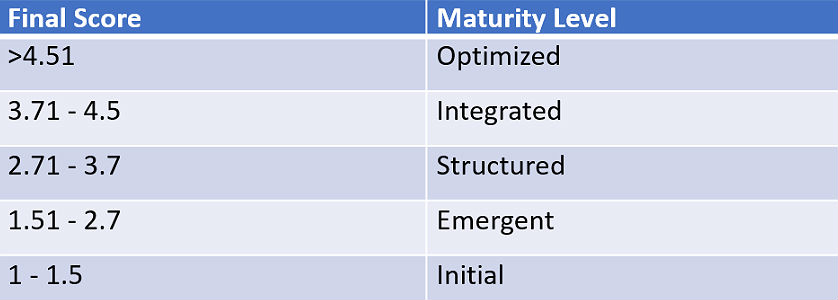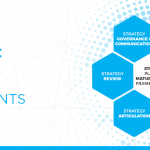Conducting a Strategy and Performance Management Audit

Organizations change forms. They either do so in response to the external environment or as a result of organizational change. Much often thrown around and bandied about, change is however no longer the buzzword in performance management. The word we have been faced with more frequently these days is transformation or transformation led change.
Organizational transformation refers to such activities as re-engineering, redesigning and redefining organizational systems and it can involve operational refinement, strategic reconfiguration or corporate self-renewal.
Of most interest in regards to the performance management discipline, strategic transformation can be defined as the process of redefining business objectives, developing new competencies and harnessing internal capabilities to drive sustainable competitive advantage and meet market opportunities.
Major Challenges Encountered in the Strategic Transformation Process
In a world of fast-paced change, the requirement for swift adaptability is the most difficult to fulfill. Not only that organizations today seek transformation, but they expect a speedy completion cycle to come with it. This requires a level of alignment and integration that most organizations are not yet prepared to handle.
Major transformation challenges also come with the following:
A) Mapping the transformation process
Even if involved with leading the transformation process, most organizations fail to dive into the end-to-end roadmap and experiences that come with the transformation process itself, thereby increasing the potential for risk or failure.
B) Shaping a clear strategic identity with which the main stakeholders of the organization can identify
With most organizations, the importance of an organizational identity is generally perceived from a marketing perspective, and seldom from a more intrinsic perspective, that is, a way to engage the internal and external stakeholders of the organization.
C) Employing the right framework and tools to lead the transformation process
The main reason organizational transformation does not often deliver the value sought is because it does not follow through on a solid framework and comprehensive set of tools that link organizational strategy to transformation ambition to strategy execution.
D) Strengthening the internal capabilities that govern organizational transformation
Most organizations fail to engage and drive focus on the capabilities required to achieve transformational change. While pivoting on the preservation of their resources, many organizations tend to save on the most important cost of transformation: the cost of knowledge acquisition through training.
E) Adding communication best practices to transformation teams in charge of managing transformational change
For most organizations, the transformation process does not manage to instill shared perspectives and agreed-upon objectives. This is mainly due to faulty or absent communication, that consequently leads to lack of transparency and common vision.

Managing Strategic Transformation with a Strategic Audit
In the process of transformation an audit provides a means to overcome transformation challenges. Traditionally, a performance audit refers to the examination of internal programs, management systems and procedures to assess whether the organization is achieving economic efficiency and effectiveness with the resources available.
A Strategy and Performance Management Audit is more specific in the sense that it assesses the design and application of the Performance Management System within an organization by analyzing several or all of its components.
Some of the main reasons the Strategy and Performance Management Audit can be a valuable tool for managing strategic transformation are as follows:
- Provides a solid framework that guides an organization through the transformation process;
- Enables comparison between the design of the Performance Management System as it is and the Performance Management System as it should be;
- Identifies the gaps in the current design of the Performance Management System while providing best practice recommendations on how to close them and achieve full integration;
- Maximizes the added value generated through transformation by elevating current performance management practices to best performance management practices in terms of system design and functionality;
- Ensures sustainable progress with the transformation process by providing a roadmap for successful strategy implementation and continuous improvement thereon;
- Educates stakeholders to embrace communication, continuous learning and improvement;
- Justifies further investments in people training, process improvement and technological infrastructure to successfully conduct strategic transformation throughout the whole transformation cycle.

The GPAU and its Strategy & Performance Management Audit
Under the flag of its Global Performance Audit Unit, The KPI Institute is addressing organizational transformation through its Strategy and Performance Management Audit Framework.
The framework is build on maturity models that cover 5 components of a Strategy and Performance Management System with the ultimate purpose of achieving full integration among these components: Strategic Planning, Performance Measurement, Performance Management, Performance Culture and Employee Performance Management.
The purpose of the audit is to indicate the strengths and weaknesses of the existing strategy and performance management system within an organization, as well as improve current performance management practices to the point where integration is achieved.
The Performance Measurement Audit Report relies on insights collected from three sources: Evidence-based assessment; Perception-based analysis; Interview-based analysis.
The methodology used includes primary research, both quantitative (survey) and qualitative (questionnaire), as well as, secondary research (documents analysis). These 3 perspectives provide a comprehensive overview on the maturity level of the strategy and performance management system within the organization.
- Evidence-Based Assessment
The evidence-based assessment relies on the submission and review of a comprehensive set of internal documents collected and submitted by the client organization.
The documents submitted are examined based on a set of 112 statements that reflect best practices on strategy and performance management and capture the main characteristics of the existing strategy and performance management system as scored by the Performance Audit Practitioner on a scale from 1 to 5.
The overall score is calculated as the average of the scores for each statement.
- Perception-Based Analysis
The perception-based analysis is based on a survey designed to reflect the opinion of employees on strategy and performance related practices within the organization.
The survey contains 160 statements that reflect on best practices and are rated on a scale from 1 to 5, based on the extent to which they are applied in the organization.
- Interview-Based Analysis
The interview-based analysis is performed based on an interview guide which reflects both the evidence and perception-based analysis, designed to ensure consistency in results and to gain a better understanding of the audit findings.
The existence, use and characteristics of relevant internal documents are validated during the interviews, while statements with highest variation in the Perception-Based survey are further discussed in order to be clarified.
The Strategy & Performance Management Maturity Model Framework
The maturity level of the strategy and performance management system is determined by the overall scores of both the evidence and perception-based assessments. The evidence-based assessment weighs 75% of the final score, while the perception-based assessment 25%.
Statements in both the evidence and the perception-based assessments are rated on a scale from 1 to 5 (1 – To a very small extent, 2- To a small extent, 3 – To a moderate extent, 4 – To a large extent, 5 – To a very large extent), based on the extent to which they apply in the organization.
Considering the survey’s overall score, the organization can fall under the following levels of maturity:

Strategically Transforming Emergent Organizations
The KPI Institute’s most recent study on the use of KPIs and performance improvement practices within organizations worldwide has revealed a majority of performance management systems, 37%, have been appreciated as emergent.
By our standards, an emergent strategy and performance management system is one that does not benefit from formally recognized and well-articulated strategic planning and execution processes. Emergent organizations generally make random, ad-hoc use of performance measurement practices, while using little data in the decision-making process to ensure performance improvement.
So maybe the most important question to answer here is: “How does one successfully transform the emergent organization?”
Several advice is at hand as it would be given in the case of any Strategy and Performance Management Audit performed:
- Connect strategic objectives to organizational KPIs.
In many organizations strategy fails to deliver on its promises, and the most common reason for this is the misalignment between the strategic plan and the key performance indicators or the metrics the organization tracks.
- Enable the use of Performance Management Tools to drive strategy implementation.
KPIs make objectives quantifiable, providing visibility into the performance of individuals, teams, departments and organizations and enabling decision makers to act in achieving the desired outcomes.
A scorecard draws together the most relevant KPIs selected for the organization and groups them under strategic objectives. The major strength of the Balanced Scorecard is that it articulates business vision and strategy, while ensuring company-wide acceptance of the performance measures enabled to achieve the overall desired performance for the organization.
Dashboards are used to easily grasp the pulse of the organization’s day to day operations and take actions based on KPI results. The benefit of the dashboard is that it invariably complements the scorecard by monitoring KPI data on a more granular level, with direct insight into the efficiency and effectiveness of operations.
The Portfolio of Initiatives can be used both at organizational and departmental level, having the purpose of improving the management of projects and to track the performance of each initiative.
- Cascade the main Performance Management tools to all organizational levels.
Once defined, designed and developed, the main Performance Management Tools should be cascaded at lower levels of the organization.
Workshops, in this case, are recommended as they provide the ideal format to ensure that the objectives and KPIs selected for the organizational scorecard and dashboard are accurately cascaded down to department level, divisional and employee level.
- Ensure alignment between the different levels and components of the Performance Management Architecture.
Considering the strong volatility of the corporate environment, organizations are required to dedicate time and resources in ensuring an alignment between the strategic direction intended to be pursued with selected KPIs and associated initiatives.
In many organizations strategy fails to deliver, due to the misalignment between the strategic plan and KPIs tracked by the organization, for this reason it is highly recommended to review and ensure realignment at least once during a performance management cycle.
- Document and map all key processes related to performance management.
The first step in creating internal capabilities that support the development and consolidation of a performance management system within the organization is to map/document all the key processes related to strategy, performance measurement, performance management, employee performance management and performance culture within the organization.
- Include all the key organizational performance improvement procedures and tools in the Performance Management Manual of the organization.
The manual should include: benefits of the performance improvement process for the organization; presentation of the performance improvement tools & techniques; performance improvement processes descriptions; approach to engaging stakeholders in different processes; the roles and responsibilities of all stakeholders involved in performance improvement.
Image sources:

Tags: GPA Unit, Strategy, Strategy Management





